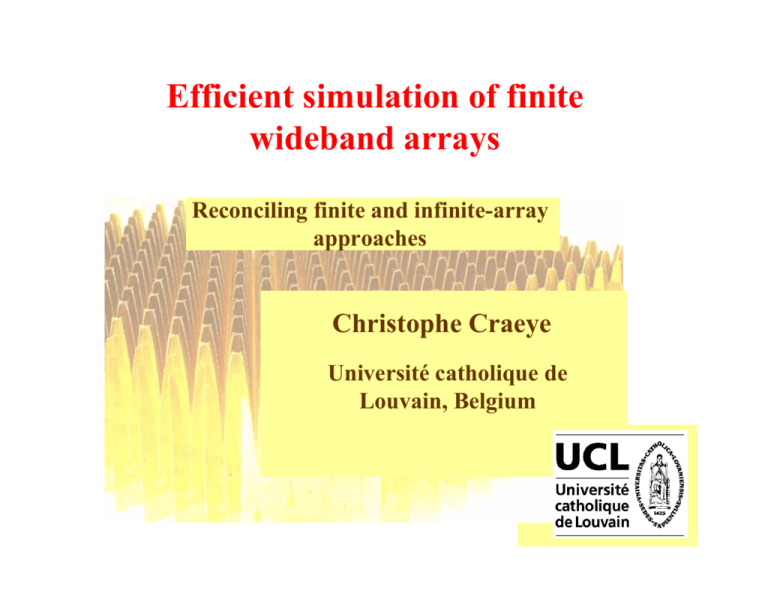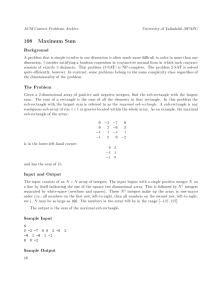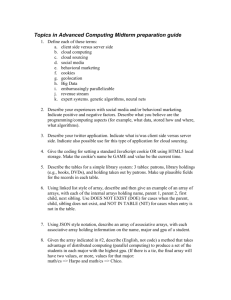Fast numerical analysis of finite antenna arrays. Application
advertisement

Efficient simulation of finite
wideband arrays
Reconciling finite and infinite-array
approaches
Christophe Craeye
Université catholique de
Louvain, Belgium
UCL ANTENNA GROUP (C. Craeye):
• Ph.D. students and post-docs: P. Druyts, R. Mateos, L.Aberbour, X. Radu,
Th. Gilles, R. Sarkis, F. Keshmiri, D. Gonzalez, X. Dardenne, N.O.
• Research eng.: M. Drouguet. RF technician: C. Kinon
• 07-08 Master’s students: P. Gerodez, M. Dorme, H. Oldenhove
Topics: metamaterials, array analysis, small wideband antennas.
Cooperations with UCL/Microwaves: I. Huynen, D. Vanhoenacker, C. Oestges.
Courses taught: antennas, electromagnetics, transmission lines, numerical
methods.
Funding sources: FNRS, Région Wallonne, Belgian Military Academy, EU
STREPS and NoE programs.
International cooperation: UMass, COST IC0603 on antennas,
COST297 on HAPs, Metamorphose NoE, Siena, HUT, DRAO,
UPC, Thalès Comm….
Outline
• Tutorial on infinite-array versus finite-array solutions
• Macro basis functions and Array Scanning methods
• Fast solutions for finite arrays with finite dielectric parts
Efficient simulation of large finite arrays
Integral equation approach
Basis functions
Unknowns
Testing:
N equations with N unknowns
N2 memory and N3 CPU time
Efficient simulation of large finite arrays
Infinite array approach
Unit cell
Plane waves
Green’s
function G
Infinite-by-infinite
p=0
Finite-by-infinite
Cylindrical waves
Element patterns at 1 GHz : exact
(from 2005 FPA meeting)
V pol
H pol
Element patterns at 1 GHz :
infinite array (from FPA2005 meeting)
V pol
Array seen from top.
Elements are
12.7x20.8 cm
H pol
Element patterns at 1 GHz :
finite-by-infinite
V pol
H pol
Element patterns at 1 GHz :
error from infinite-array
V pol
H pol
Element patterns at 1 GHz :
Error from finite-by-infinite
(*)
V pol
(*) larger errors in
corners corrected with
special procedure
(*)
H pol
Wave phenomenology in finite arrays
Finite-by-infinite array
port
currents
Reflected by
array ends
Generated by single
Reflected by
source in periodic
array ends
structure
~ same distributions as forward
wave, except for edge elements
Brute infinite-array solution
Finite-by-infinite array
Brute truncation of infinite-array current distributions:
• scattering by edges is omitted
• parasitic contributions from complementary arrays
• limited to periodic excitation
Windowing 1 method
Finite-by-infinite array
Reflected by
array ends
Reflection by array ends:
not accounted for
Array pattern= embedded element pattern, sampled and convoluted by FT of window
A. Roederer, ``Etude des réseaux finis de guides rectangulaires à
parois épaisses,'' L'onde Electrique, vol. 51, pp. 854-861, Nov. 1971.
Windowing 2 method
Finite-by-infinite array
Solve for this element
Assuming that others have the same
(phase-shifted) current distribution
(periodic excitation)
A.K. Skrivervik and J.R. Mosig, Analysis of finite phased arrays of
microstrip patches, IEEE Trans. Antennas Propagat., vol. 41, pp. 11051114, Aug. 1993.
Wave phenomenology in finite arrays
Finite-by-infinite array
port
currents
Reflected by
array ends
Generated by single
Reflected by
source in periodic
array ends
structure
~ same distributions as forward
wave, except for edge elements
Array Scanning Method with finite resolution
Current at ant. m
for ant. 0 excited
Infinite-array solution for phase
shift ψ between elements
Aliasing:
Repetition of source
every N elements
15 min
Array Scanning Method with
finite resolution
Finite-by-infinite array
Reflected by
array ends
Generated by single
Reflected by
source in periodic structure array ends
Aliased through discrete array
scanning method
C. Craeye and R. Sarkis, Finite array analysis through combination of Macro
Basis Functions and Array Scanning methods, ACES conference 2007.
Macro Basis Function approach
Current distribution = superposition of distributions
obtained in small problems
e.g. a single antenna with « a whole spectrum » of excitations
Problem with connected elements: edge currents
Possible solution: extend the element somewhat
(cf. Maaskant et al.) and/or introduce some resistive
tapering at the edges.
Macro Basis Function approach
Isolated element
Use ASM solutions as MBF’s ☺ !
Elt 1
Elt 2
Elt 4
Elt 8
Macro Basis Function
approach
Use ASM solutions as MBF’s ☺ !
ASM solutions: linear
combinations of infinitearray solutions
Use infinite-array solutions !
Requirement: regularly distributed in reciprocal space (ψ space)
Macro Basis Function
approach
π
π b/(λ/2)
−π
ψy
π a/(λ/2)
invisible space
π
visible space
ψx
−π
Requirement: regularly distributed in reciprocal space (ψ space)
NB: Can be relaxed somehow (under study)
Add edge current distributions
2X2 array simulations
add 8 independent current distributions
NB: can be reduced to single cell problem through symmetry
Numerical results for a 5X5 array
E-plane pattern
50 dB !!!
error
12.7 cm
Embedded element pattern
for corner element at 1 GHz
Current distribution in « tough » truncation case
λ=60, corner
element, for center
element excited
Error for 2X2 ASM
Error for 4X4 ASM
Port currents at 500 MHz
-50
-50
dB
« exact » for 3 different excitations
-100
-100
-150
errors
MBFs from 2X2 ASM
MBFs from 4X4 ASM
Analysis of anomalies
π
π b/(λ/2)
−π
ψy
π a/(λ/2)
ψx
−π
Singularities lead to slowly decaying current distributions.
Also captured in spectral (ψx, ψy) domain.
Analysis of anomalies
1 GHz
1.56 GHz anomalous
currents at broadside
1.56 GHz, eigenvector with
lowest eigenvalue
Analysis of anomalies
16x
array with element 9
excited at 1.56 GHz
-50
Coefficient of
solution
« exact »
-150
error
Index of elementary basis function
Only 8 MBFs are used
NB: anomaly outside regular grid can be treated in similar way
Analysis of anomalies
5x5 array with first element
excited at 1.56 GHz
Port current
« exact »
Error N=2
Error N=4
Error N=6
Element index
Fast treatment of elements with finite dielectrics
Method of Moments, with surface equivalence
J
M
J
Vector of unknowns on a given antenna: x =
30 min
Structure of MoM impedance matrix
…
ZN1
x1
v1
=
…
Z21 Z22
Z1N
ZNN
…
Z11 Z12
xN
vN
Diagonal block
Off-diagonal block
ZEJ ZEJ ZEM metal
0
0
ZEJ ZEJ ZEM
0
ZEJ
ZEM
0
ZHJ
ZHM
ZHM ZHJ ZHM
metal
dielectric
dielectric
0
Large time saving for
complex elements
Choice of Macro Basis Functions
Unknowns
Solution on any
given unit cell
Solutions from
small problems
« macro » or
« characteristic »
basis functions
Will be replaced
by ASM approach
(see above)
secondary
solution
primary
solution
secondary
solution
J. Yeo, V. Prakash, and R. Mittra, Efficient analysis of a class of microstrip
antennas using the CBFM, MOTL, vol. 39, pp. 456–464, Dec. 2003.
Testing procedure
Interaction between MBF’s:
Jb
Mb
Hs
Es
Jt
Mt
Involves only equivalent surface currents
Independent from complexity of antennas inside !!!
Interaction between MBF’s
Matrix form:
e.g., for non-self-block:
J*m J*s
M*
0
0
0
Jm
0
ZEJ
ZEM
Js
0
ZHJ
ZHM
M
Does not involve the
metallic part inside the
dielectric volume !!!
Slow !!! Nb2 process, with Nb number of surface
unknowns, complex elementary computations
Fast interaction using Multipoles:
Interaction over
unit sphere
Multipole
E and H interaction translation
function
between MBF
patterns
If Nb of the order of number of directions (a few hundred), Nb-process !!!
NB: no aggregation nor disaggregation
Fast interaction using Multipoles:
The special MBF patterns:
Pattern of divergence
NB: 2 times
« cheaper»
formulation in
preparation
F: pattern from electric current
G: pattern from magnetic current
Substript: t for testing MBF
b for basis MBF
Array impedance matrix
Reduced admittance matrix:
Matrix with list of MBFs
line corresponding to feeding point
(delta-gap source) with width W
Element of array
admittance matrix
Array pattern and/or embedded
element pattern
1. Get solution for given excitation from MBF approach, e.g.
excitation at a single port.
2. Compute far field pattern by brute-force from equivalent
currents on dielectric-air interface:
polarisation
Sum on array elements
Array factorisation
MBF pattern can
be factored out !!!
C21
C31
MBF 2
C12
C22
C32
…
C11
…
MBF 1
…
…
Antennas
Coefficients for
IDENTICAL current
distribution
Embedded element pattern
Finite series of pattern multiplication problems:
Pattern of a given MBF:
Have been computed in the course of MBF-Multipole computation !!!
Embedded element pattern
Array factor:
N log N complexity, with N = Max { M, D} !
Antennas; directions
Array of Vivaldi antennas
10x10 array
Width 13 cm
Spacing: 14 cm
Height: 21 cm
Wavelength: 30 cm
εr= 4
Validation for 4X4 array
Active input impedances
4X4 array
Width 13 cm
Spacing: 14 cm
resistance
Height: 21 cm
MBF approach
Wavelength: 30 cm
Brute force
reactance
ε r= 4
More complex antenna
Tapered-slot antenna with
complex balun
• 1402 unknowns on the metallic
antenna
• 2 x 380 unknowns on the
dielectric box
• 16 X 16 array
553.472 unknowns
Balun structure from DRAO, Penticton, Canada.
Meshing and runnig by C. Grevet, Toulouse,
France.
256 solutions in ~30 minutes
on old laptop
Conclusions
• ASM is a key tool for infinite and finite array analysis.
• Link with « windowing » methods.
• MBFs from ASM + 2X2 array analysis.
• Highly accurate, allows to catch « anomalies ».
• MBFs extended to antennas with finite dielectrics
• Interactions between MBFs accelerated with Multipoles
(less-than-N complexity for complex antennas)
• Array impedance matrix obtained from reduced MoM matrix
• Very fast pattern evaluation:
Finite series of pattern multiplication problems
With MBF patterns computed in multipoles process
With array factors computed with FFT
Extensions in progress
• Treatment of cells connected through dielectrics
• Extension to multiple dielectric materials
• Further investigation of analysis of anomalies
• Analysis of complex eigenmodes (e.g. for leaky waves)
• Fast analysis of irregular arrays with similar method
• Analysis of complex feeding structures
• Joint analysis of antennas and supporting structures
• Experimental validation
Journal papers in the field of array analysis
[1] Craeye C., Smolders A.B., Schaubert D.H., Tijhuis A.G., An efficient scheme for the computation of
the Green’s function of a two-dimensional semi-infinite array, IEEE Trans. AP, vol. 51, pp. 766-771,
April 2003.
[2] Craeye C., Arts M., Modulated oscillations appearing in the scan impedance of a finite phased array,
IEEE Trans. AP, vol.51, pp. 2504-2506, September 2003.
[3] Craeye C., Tijhuis A.G., Schaubert D.H., An efficient MoM formulation for finite-by-infinite arrays
of two-dimensional antennas arranged in a three-dimensional structure, IEEE Trans. AP, January 2004.
[4] Craeye C., Arts M., On the receiving cross-section of an antenna in infinite linear and planar arrays,
Radio Science, April 2004.
[5] Craeye C., Parvais B., Dardenne X., Signal-to-noise patterns in infinite and finite receiving antenna
arrays, IEEE Trans. AP, December 2004.
[6] Craeye C., Including spatial correlation of thermal noise in the noise model of high-sensitivity arrays,
IEEE Transactions on Antennas and Propagation, vol. 53, pp. 3845 – 3848, Nov. 2005.
[7] Craeye C., Dardenne X., Element pattern analysis of wideband arrays with the help of a finite-byinfinite array approach, IEEE Transactions on Antennas and Propagation, Vol. 54, pp. 519 – 526, Feb.
2006.
[8] Craeye C., Capolino F., Accelerated computation of the free-space Green’s function of twodimensional semi-infinite and infinite arrays, IEEE Trans. AP, vol. 54, 1037-1040, March 2006.
[9] Craeye C., A.O. Boryssenko, D.H. Schaubert, Wave propagation and coupling in linear arrays with
application to the analysis of large arrays, IEEE Trans. AP, vol. 54, pp. 1971-1978, July 2006.
[10] Craeye C., Fast impedance and pattern computations in finite antenna arrays, IEEE Trans. AP, vol.
54, pp. 3030-3034, October 2006.
[11] Craeye C. and R. Sarkis, Finite array analysis through combination of array scanning and macro
basis function approaches, Accepted for publication in ACES Journal.
[12] X. Dardenne and C. Craeye, Method of Moments simulation of infinitely periodic structures
combining metal with connected dielectric objects, submitted to IEEE Transactions AP, July 2007.
[13] C. Craeye, Th. Gilles and C. Craeye, Fast analysis of finite arrays of antennas involving dielectric
parts, submitted to Radio Science, November 2007.
Simulations versus measurements
S11 for Ultra-wideband monopole with complex shape
That low-freq. discrepancy
has been fixed recently
-10 dB
-20 dB
1 GHz
by Farshad Keshmiri and David Gonzalez, Nov. 2007
S12 validations in progress
2 GHz
frequency






